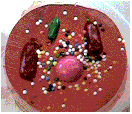
The incredible edible cell!
1. Getting ready:
A. Making the "cytoplasm"-Following directions on the box, mix up batches of Jello gelatin. Pick a light colored flavor (lime for plants, strawberry for animals). Every 6 oz package will make 4 or 5 "cells". Add some unflavored gelatin to the Jello to make it a little stiffer (regular Jello may fall apart). Pour the Jello mixture into 9 oz. clear plastic cups, one per group, until they are about two-thirds full. Put them into a refrigerator to set. The Jello cups will last a long time, so this can be done well in advance if necessary.
B. Gathering the "organelles"-Collect other food materials to represent the organelles that will be studied. Try to choose food items that would look similar in shape and size to the real thing. Here are some suggestions:

The incredible edible cell!
|
|
|
|
Golgi Bodies |
2 blue or green pieces of fruit roll up |
|
Endoplasmic Reticulum |
2 red or yellow pieces of fruit roll up |
|
Ribosomes |
1 teaspoon of round cake sprinkles |
|
Mitochondria |
4 hot tamale candies |
|
Vacuoles |
4 chocolate covered raisins |
|
Plant Cell central vacuole |
1 large white marshmallow |
|
Nucleus |
1 pink gumball |
|
Cell wall |
a sheet of green fruit roll up |
|
Plant Central Vacuole |
1 large white gumball |
C. Collecting Building Supplies-You will need a paper plate and a plastic knife and spoon, as well as a tray for all your building materials.
2. Building your cells:
A. Extract the Jello from the plastic cup and put it on the paper plate. You may need to run the knife around the very outside edge of the Jello to loosen it, or try running warm water over the cup.B. Cut the Jello in half and remove the top half. Turn over the top and set it on the plate beside the bottom.
C. Use the spoon to dig out a hole in the bottom half of the Jello cytoplasm. Place the gumball in this hole to represent the nucleus of the cell. (For a plant cell, the large vacuole goes in the middle and the nucleus is off to one side.)
D. Using the spoon to make spaces, place the other cell parts into the cell. Parts can be put into both the top and bottom half of the Jello cell.
E. Take the top part of the cell and carefully place it back on top. If the cell feels soft, you can put the parts back into the plastic cup, then turn it over onto the paper plate. Then carefully remove the plastic cup.
F. Congratulations! You're done. If you kept your work area clean, and remembered to wash your hands before you began, you may now eat your cell!
Source: Access Excellence website. http://www.accessexcellence.org